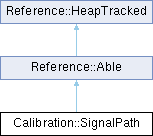 PSRCHIVE
PSRCHIVE
| Ask a Question | Search PSRCHIVE: |
 PSRCHIVE
PSRCHIVE
| Ask a Question | Search PSRCHIVE: |
 Home Home
|
Public Member Functions |
Public Attributes |
Static Public Attributes |
Protected Types |
Protected Member Functions |
Protected Attributes |
List of all members
Calibration::SignalPath Class Reference Manages multiple signal path transformations in a reception model. More...
Inheritance diagram for Calibration::SignalPath:

Detailed DescriptionManages multiple signal path transformations in a reception model. As in Table 1 of van Straten (2004), different types of observations are subjected to different polarimetric transformations. Each SignalPath instance manages the polarimetric tranformations for observations of a single pulsar, its reference source (e.g. noise diode), and a flux calibrator. Multiple pulsars are managed by multiple SignalPaths that share a reception model and a common set of polarimetric transformations. Member Function Documentation◆ add_psr_path()
Add a new signal path for pulsar observations. Signal path experienced by pulsar signal References add_transformation(), equation, faraday_rotation, Calibration::VariableBackendEstimate::get_psr_response(), projection, and verbose. ◆ get_equation()
Get the measurement equation. Get the measurement equation solver. References equation. Referenced by get_covariance(), and solve(). ◆ get_pulsar_transformation()
Get the full signal path experienced by the pulsar. Get the signal path experienced by the pulsar. References get_backend(). ◆ max_weight_backend()
Get the backend with the maximum weight. return the backend with the maximum weight References backends. Referenced by get_covariance(). ◆ share()
Share reception model and common transformations of other instance. Common transformations are experienced by all sources. References equation, faraday_rotation, impurity, projection, response, and SignalPath(). Member Data Documentation◆ backends
The set of instrumental backend transformations for each epoch. The VariableBackendEstimate class handles jumps in the instrumental response that apply to both calibrator and pulsar observations. Referenced by add_observation_epoch(), add_step(), disengage_time_variations(), engage_time_variations(), get_backend(), get_covariance(), max_weight_backend(), reduce_nfree(), set_constant_pulsar_gain(), set_diff_gain_variation(), set_diff_phase_variation(), set_gain_variation(), set_refcal_through_frontend(), set_reference_epoch(), solve(), and update(). ◆ impurity
The (optional) common instrumental impurity to be modelled. When used, all signal paths include this transformation, which supplements the response to be modeled and output as a solution. Referenced by add_transformation(), set_impurity(), share(), and solve(). ◆ response
The common instrumental response to be modelled. All signal paths include this transformation, which is the response to be modeled and output as a solution. Other transformations mostly deal with variations as a function of time, variations between signals of different types, etc. Referenced by add_step(), copy_transformation(), disengage_time_variations(), equal_ellipticities(), fit_gain(), fix_orientation(), get_covariance(), get_transformation(), reset(), set_basis(), set_response(), share(), and update(). ◆ solution_response
The instrumental response returned by get_transformation. Place holder for fiducial solution when there are multiple signal paths. Referenced by get_covariance(), and get_transformation(). The documentation for this class was generated from the following files:
Generated using doxygen 1.14.0
|
||||||||||||||||||||||||||||||||||||||||||||||||||||||||||||||||||||||||||||||||||||||||||||||||||||||||||||||||||||||||||||||||||||||||||||||||||||||||||||||||||||||||||||||||||||||||||||||||||||||||||||||||||||||||||||||||||||||||||||||||||||||||||||||||||||||||||||||||||||||||||||||||||||||||||||||||||||||||||||||||||||||||||||||||||||||||||||||||||||||||||||||||||||||||||||||||||||||||||||||||||||||||||||||||||||||||||||||||||||||||||||||||||||||